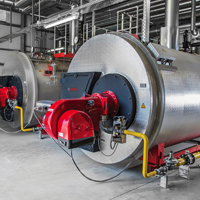 Under Pressure: Can Your Steam Boiler Handle It
Under Pressure: Can Your Steam Boiler Handle It
With fluctuations in steam pressure having the potential to affect energy savings, environmental credentials, and wear and tear to boiler components, it is vital that boilers operates to the correct design pressure at all times.
Matthew Walton, Contracts Manager for Industrial Boilers at Bosch Commercial and Industrial, explains how this (Read More)
is best achieved.
“Once associated with the industrial revolution, steam is an essential product for a multitude of modern technologies. Demand spans both the private and public sectors with applications varying from power stations through to food and drink manufacture.
“Steam releases a large amount of heat when it condenses and so can carry vast quantities of energy. However, for users to capitalise on this precise system control is required to provide the correct amount of high quality steam safely, efficiently and at the correct pressure.
Water levels
“During steam generation inconsistent pressure levels can have a significant impact on water levels within the boiler, leading to operational downtime if not maintained correctly. As a boiler generates steam, any impurities will not boil off and therefore concentrate. As these impurities become more concentrated a foam will form which can be carried over into the steam main.
“These seemingly harmless bubbles can lead to serious issues. At a base level the foam can result in a false reading for the water level. Additionally, it means not only is the steam wet as it leaves the boiler, resulting in poor quality steam also known as “carry-over”, but the water also contains high levels of dissolved and suspended solid that can contaminate boiler system components such as control valves and heat exchangers.
“As foam does not transfer heat as quickly as water it can lead to a serious failure or even an explosion as furnace metals reach softening point. Therefore, it is vitally important that control measures are put in place to ensure the correct water level is maintained at all times.
Effects of water carry-over
“Water carry-over is contaminant that leaves the boiler with the steam be that in solid, liquid, or vapour form, resulting in water hammer and the corrosion of vital boiler components. Aside from damage to the system, an often overlooked consequence of carry-over is the efficiency loss due to wet steam. Since water at a given pressure has lower heat content than steam, wet steam has lower heat content than dry steam.
“The causes of carry-over are generally either mechanical, namely boiler design, high water level, firing method, and load characteristics or chemical, due to high solids concentration, excessive alkalinity, grease or oil. Carry-over can usually be verified by testing, with low conductivity condensate indicating high purity steam, while high results indicate the presence of carry-over.
“While all process users need high quality steam, it is important to remember that this depends on the ability to maintain the correct steam pressure to ensure it can separate from boiling water without carrying water particles with it throughout the entire system operation, rather than on the efficiency of the boiler.
“Even the most well-designed and operated boiler system will produce minor amounts of water carry-over however, the key is to know how much can be tolerated and then operate accordingly to achieve the required steam purity.
For more information on Bosch Commercial
and Industrial and its range of
products and services please visit:
www.bosch-industrial.co.uk
or call 0330 123 3004.
Alternatively, follow Bosch Commercial and Industrial on Twitter (@BoschHeating_UK) and LinkedIn (Bosch Commercial and Industrial UK).



